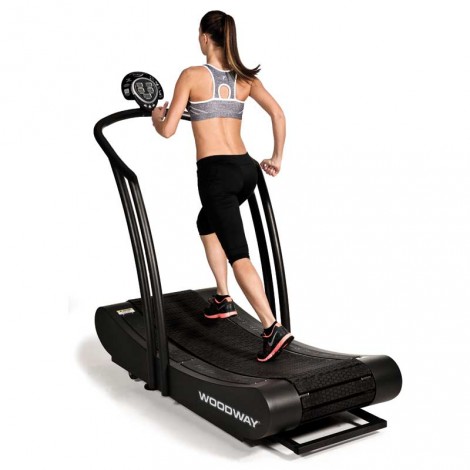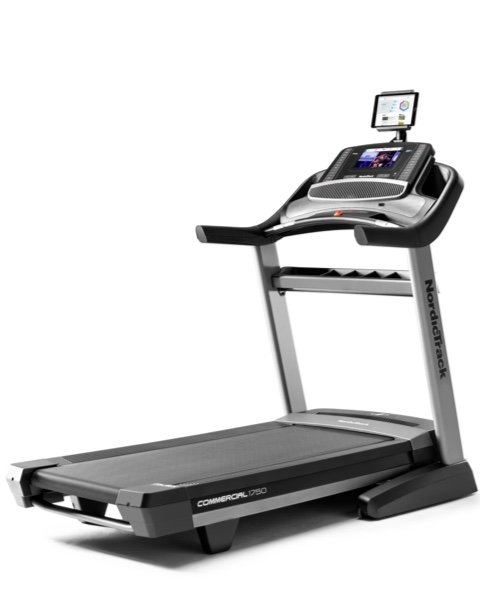Curved Treadmills: Everything You Need to Know
One of the newest entries in the area of commercial and home gym equipment is the curved treadmill.
These unique treadmills are opening a lot of eyes, both in the fitness and scientific communities, and may very well change our entire approach to running workouts over time.
What is a curved treadmill and how is it different from a traditional treadmill?

As the name suggests, a curved treadmill is designed with a slightly curved, kidney-shaped running surface. Like traditional treadmills, these machines use walking or running for a cardio workout. The main difference between the two types of treadmill is that a curved treadmill is entirely manually powered.
You control the movement and speed of the running surface with your own legs rather than relying on battery or electrical power like traditional treadmills use. Because of the slight curve to the running surface, you use the balls of your feet to propel the belt backward with each step while your body remains stationary and centered.
In order to achieve this smooth, more natural movement the running surface of curved treadmills is constructed of a series of individual slats rather than one solid belt. As your feet impact each slat, the slats move smoothly around the curved surface creating a comfortable, easy glide.
Instead of relying on a pre-set program to achieve and maintain pace, curved treadmills rely on a combination of friction, gravity and your natural stride. You simply step onto the machine and start moving to set the pace and when you want to stop, just stop moving and the machine stops with you.
The slight curve of the running surface means your stride will begin and end at the edge of a natural arc, which automatically encourages you to walk or run on the balls of your feet and push off with your toes.
This creates a much more natural stride and promotes better posture. At the same time, the curve also decreases impact, making curved treadmills that much easier on individuals with joint or mobility issues.
Benefits of Using A Curved Treadmill
While both traditional and curved treadmills are designed for walking and running, there are some particular ways that a curved treadmill can enhance your workout, including allowing you to burn more calories while increasing both heart rate and oxygen consumption.
One study from Australia showed that the average heart rate was 20 beats per minute faster and oxygen consumption was 15% higher on a curved treadmill compared to a standard flat treadmill.
Since curved treadmills rely solely on manual power, not surprisingly that also translates to a more intense workout that can actually burn 30% more calories than a similar workout on a motorized treadmill. Researchers have been able to determine that running on a curved treadmill has more physiological impact than running on a flat treadmill.
The use of manual power also makes speeding up and slowing down far easier on a curved treadmill, which makes them ideal for HIIT training and sprints. It can be very difficult and even dangerous to try to slow down or change speed on a traditional motorized treadmill since your reflexes weaken as the workout tires you, which can make trying to find and change the setting of the machine a challenge. On a curved treadmill all you have to do to slow down or stop is to stop moving.
Another key difference in workouts between traditional motorized treadmills and curved treadmills is the impact on joints. The slight curve of the running surface combined with a cushioned rubber surface makes for a much more comfortable low impact workout that is easier on the knees, hips, ankles and back.
With the more natural feel of a curved treadmill, there is less pounding as your feet impact a flat surface like a traditional treadmill or the ground, which translates to a lot less wear and tear over time.
Because traditional treadmills are motorized, they are literally doing the moving for you, which means you don’t have to engage every muscle group, particularly those in the lower body.
In contrast, with a manually powered curved treadmill you are doing all of the work, which means your entire posterior chain, including the glutes, calves and hamstrings are being used. The end result is a much more complete total body workout.
Not only are you engaging your lower body, the design of curved treadmills also helps to promote better posture as you are able to run on the balls of your feet and stay more upright and centered throughout your workout. This has been shown to improve stride length, gait and balance.
Curved Treadmills: Pros and Cons
Of course, as with any kind of exercise equipment, curved treadmills certainly have their benefits and their limitations. It’s worth considering all of the potential pros and cons before you decide whether to invest in one of these new and innovative treadmills.
PROS
1. Safety – As I mentioned above, since you start and stop a curved treadmill manually, that makes for a much safer overall experience as there isn’t the potential danger of being thrown or slipping. Curved treadmills are also designed with more slip-resistant surfaces to allow for a better grip and since they lack motors there is no fire safety issue.
2. More Energy Efficient/Environmentally Friendly – Since there’s no electricity involved, that means you won’t be running up your electricity bill and you don’t have to worry about positioning your machine near an outlet. At the same time, there is no carbon footprint involved which makes them an ideal choice for environmentally conscious users.
3. Easy to use – Step on and start running, it doesn’t get much easier than that! There’s no complicated software to learn, no buttons to push and no need to wait for the machine to warm up before you can use it. And you control how fast or slow you go and when you want to stop. There are some models that also include adjustable resistance for a more challenging workout but that’s about as complicated as it gets.
4. Low maintenance – No motorized parts means nothing to break down so you won’t have to worry about your treadmill giving out on you or having to spend a lot of money on repairs or replacement.
CONS
1. Price – Probably the biggest drawback of curved treadmills at this point is their price. Because they are still relatively new on the market, manufacturers still need to charge a substantial price to get any return on their investment. For this reason, curved treadmills are among the most expensive pieces of exercise equipment you’ll find. Even the cheapest models are well over $2,000, putting them out of the reach for many consumers. There is room for hope, though. As these treadmills continue to gain in popularity and demand increases, prices are very likely to come down over time.
2. Size – Curved treadmills tend to have a much larger footprint than traditional treadmills and as they are new to the market, there aren’t as many options available. Traditional treadmills can often be found in more compact, foldable models, which are easier to move and store. Again, over time this is likely to change as manufacturers begin to see an increased demand.
3. Require more concentration – As I found out the first time I tried a curved treadmill, they do take some getting used to, which means having to focus on what you’re doing as you work to maintain the proper posture and find your stride. That means that if you’re looking to take a nice, leisurely run while watching your favorite TV show or listening to music and not think about what you’re doing, this probably isn’t the machine for you.
4. No Bells and Whistles – Most curved treadmills are pretty basic, meaning they lack the electronic bells and whistles you’d find on more traditional workout machines, including big screens, Bluetooth capability and built-in fans. So if that’s your main focus when it comes to working out, you’ll be disappointed.
What Are Some of the Best Curve Treadmills Out There?
If you do want to invest in a curved treadmill, you’ll want to investigate all the available options. You’ll find models available from makers including Assault Fitness, Technogym, Woodway, Resolve and NOHrD among others.
Woodway was the first manufacturer of curved treadmills, with its earliest design released in 1974. The Woodway Curve is still considered the standard among pro athletes and rehabilitation centers, but it carries a hefty price tag along with that reputation.
The Technogym Skillmill is the most expensive model on the market at just over $12,000, putting it well out of the reach of most ordinary budgets but it does carry a few more high end features including pre-programmed workouts and a large built-in screen.
Assault Fitness has a few models ranging around the $3,000 mark, which makes it one of the more affordable brands of curved treadmills. The Assault AirRunner that I tried was desgined with athletes in mind but it was still fairly easy to use and it did include some nice features including Bluetooth capability and a nicer looking interface on its built-in screen than many other models. It is also slightly smaller and lighter weight than most curved treadmills, making it easier to move.
Probably the most unique of all the curved treadmills is the Sprintbok, from NOHrD, which has a frame and slats made of rich hardwood. This gives it a one-of-a-kind aesthetic that makes it much more attractive than your standard gym equipment.
The wood also serves a functional purpose as it absorbs vibrations much better than metal, making for a much quieter performance ideal for the home gym. It also features a 17” LCD screen and pre-programmed workouts unlike most curved treadmills. Of course all of this comes with an equally impressive price tag, retailing at around $7,500.
What's the bottom line?
When it comes right down to it, stepping onto a treadmill and using your own power seems like a logical and intuitive approach to working out and that is exactly what curved treadmills are gradually beginning to prove.
They are still very new to the exercise market so there’s a lot of research and consumer trial to be done but there’s little denying the quality of the workout you can get from one of these treadmills, whether you’re a serious runner or just looking to get up and moving.
Over time, as we learn more about the specific benefits of curved treadmills we’ll probably see the market increase and prices come back down to earth. For the time being, it remains a great way to get a quality high intensity, low impact workout if your budget can stretch enough to afford it.
UPDATE: April Treadmill Sales are on!
SEE THE BEST CURRENT DEALS HERE
Best By Price
Cheap
Under $500
$500-$1000
$1000-$2000
$2000-$3000
$3000-$4000+
Best By Type
Best Overall
Best For Walkers
Best For Runners
Best Incline
Best Folding
Best Manual
Consumer Reviews

Rave or rant about the treadmill you bought or used at the fitness center. Read reviews submitted by others.

